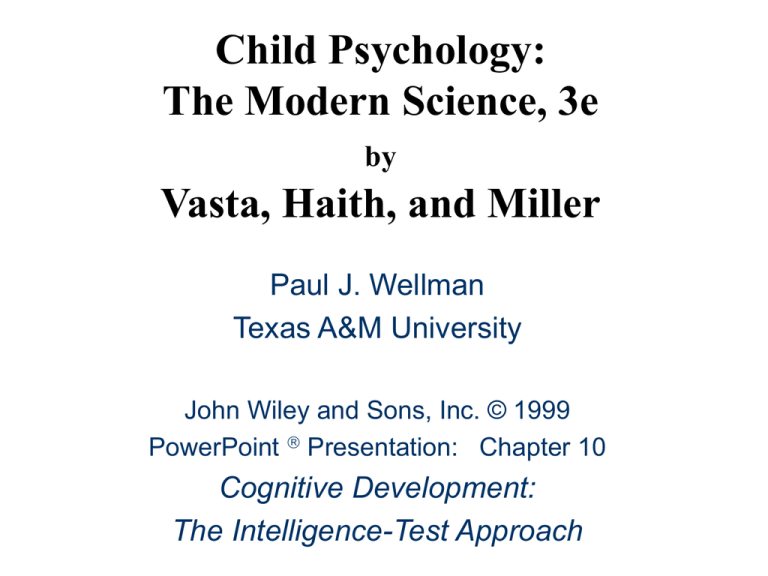
Child Psychology:
The Modern Science, 3e
by
Vasta, Haith, and Miller
Paul J. Wellman
Texas A&M University
John Wiley and Sons, Inc. © 1999
PowerPoint Presentation: Chapter 10
Cognitive Development:
The Intelligence-Test Approach
The Psychometric Approach
The Psychometric approach to intelligence
focuses on the use of standardized tests to
identify individual differences among
people
– IQ tests yield ordered differences among
people
• Results in an evaluative dimension in which person
A is less or more intelligent than person B
– IQ tests are pragmatically oriented
• Determine the type of education a student should
receive
© 1999 John Wiley and Sons, Inc.
Nature of IQ Tests
Binet approach was developed in 1905
by Alfred Binet and T. Simon. The
purpose was to measure individual
differences in intellectual ability.
Wechsler approach involves a verbal
scale and a performance scale
More recent entries include group tests
of intelligence
© 1999 John Wiley and Sons, Inc.
Distribution of IQ Scores in
Children
(Figure adapted with permission from Stanford-Binet Intelligence Scale, (3rd ed., p.18) by L.M. Terman and M.A.
Merrill, 1973, Chicago: The Riverside Publishing Company. Copyright 1973 © by The Riverside Publishing Company)
© 1999 John Wiley and Sons, Inc.
Vasta, 3e Fig.10.1
Wechsler Intelligence Test Items
SUBTEST
VERBAL SCALE
Information
How many wings does a bird have?
What is a pepper?
If two apples cost $.15, what will be
the cost of a dozen apples?
What is does _____ mean?
Hammer
Epidemic
Protect
Arithmetic
Vocabulary
(Adapted with permission from Weschler Intelligence Scale for Children-Third Edition.
Copyright © 1991 by The Psychological Corporation)
© 1999 John Wiley and Sons, Inc.
Wechsler Intelligence Test Items
SUBTEST
PERFORMANCE SCALE
Object Assembly
Put the pieces below together to
make a familiar object
(Adapted with permission from Weschler Intelligence Scale for Children-Third Edition.
Copyright © 1991 by The Psychological Corporation)
© 1999 John Wiley and Sons, Inc.
Evaluating Intelligence Tests
Characteristics of a good psychometric
test include
– Reliability which asks whether the test gives
repeatable scores (consistency of
measurement)
– Validity which asks whether the test
measures the intended domain
• Criterion validity determines whether IQ can
predict a criterion such as school performance
• IQ scores correlate 0.5 with school performance
© 1999 John Wiley and Sons, Inc.
The Structure of Intelligence
Core issue asks: what is the underlying
structure of intelligence?
– Number and organization of factors
– Spearman’s two-factor theory:
• One factor is general intelligence (“g”), this factor
is a part of all forms of intellect
• The other factor is “s” which refers to special
abilities
– Thurstone argued for seven primary abilities
• Verbal comprehension, verbal fluency, number,
spatial visualization, memory, reasoning, and
perceptual speed
© 1999 John Wiley and Sons, Inc.
Stability of IQ
AGE
3
3
6
9
12
6
9
12
18
.57
.53
.36
.35
.80
.74
.61
.90
.76
.78
(Based on information from “The Stability of Mental Test Performance Between Two and Eighteen Years”
by M.P. Honzik, J.W. MacFarlan, and L. Allen, J. of Experimental Education, 17, p. 325, 1948. Reprinted with permission
of the Helen Reid Educational Foundation. Published by Heldref Publications, 1319 Eighteenth St., N.W., Washington, D.C.
20036-1802. Copyright © 1948.)
© 1999 John Wiley and Sons, Inc.
Genetic Studies of IQ
Relation
Median Correlation
Siblings
Parent-Child
Grandparents-grandchild
First cousins
Second cousins
0.55
0.50
0.27
0.26
0.16
(Adapted from “Genetics and the Development of Intelligence” by S. Scarr-Salapatek, 1975. In F. Horowitz (Ed.),
Review of Child Development Research (Vol. 4, p. 33), Chicago: University of Chicago Press. Copyright © 1975 by the
University of Chicago Press)
© 1999 John Wiley and Sons, Inc.
Twin Studies of IQ
Relationship and
Rearing Condition
Ave. Corr.
Identical twins reared together
Identical twins reared apart
Fraternal twins reared together
Siblings reared together
Unrelated children reared together
.86
.72
.60
.47
.32
# Pairs
4,672
65
5,533
26,473
714
(Adapted from “Familial Studies of Intelligence: A Review” by T.J. Bouchard, Jr. and M. McGue,
1981, Science, p. 1056. Copyright © 1981 by the American Association for the Advancement of Science)
© 1999 John Wiley and Sons, Inc.
Experience and Intelligence
Early deprivation experiences can have
devastating effects on intelligence
– Rearing in an orphanage with minimal
stimulation results in profound mental
retardation
Family experiences can alter intelligence
Quantity and quality of schooling can
alter intelligence
© 1999 John Wiley and Sons, Inc.
Alternatives to IQ Tests
Vygotsky emphasized that children have
two levels of development
– Actual or current versus that of potential
development
– Vygotsky emphasized that adult assistance
can enhance intellectual performance by
closing the zone of proximal development
(the gap between actual and potential
development)
© 1999 John Wiley and Sons, Inc.
Alternatives to IQ Tests
Gardner’s Theory of Multiple Intelligences
suggests that certain forms of intelligence
(e.g. musical) are not tapped by current IQ
tests
Ceci’s Bioecological Theory suggests that
intelligence
– Results from a conjunction of cognitive
processes
– Assessment will depend on the context and
domain that is measured
© 1999 John Wiley and Sons, Inc.
Context Determines Ability to
Predict Spatial Movement
(Reprinted with permission from On Intelligence: A Bioecological Treatise on Intellectual Development by Stephen Ceci,
Cambridge, Mass.: Harvard University Press, Copyright © 1990, 1996 by the President and Fellows of Harvard College )
© 1999 John Wiley and Sons, Inc.
Vasta, 3e Fig. 10.4
Copyright
Copyright 1999 by John Wiley and Sons, New York, NY.
All rights reserved. No part of the material protected
by this copyright may be reproduced or utilized in any
form or by any means, electronic or mechanical,
including photocopying, recording, or by any
information storage and retrieval system, without
written permission of the copyright owner.



